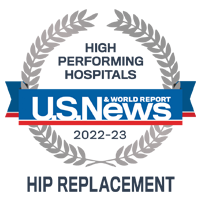
Osteoarthritis of the Hip
Osteoarthritis of the hip causes the hip joint to get stiff and inflamed and can progress until resting no longer relieves your pain. Bone spurs might build up at the edges of the joint. When the cartilage wears away completely, bones rub directly against each other, making it very painful to move. You may lose the ability to rotate, flex or extend your hip. If you become less active to avoid the pain, the muscles controlling your joint get weak and you may start to limp.
Osteoarthritis, resulting from the wear and tear of your body as you age, affects more than 20 million people in the United States. The pressure of gravity on your joints and surrounding tissues causes physical damage, leading to pain, tenderness, swelling and decreased function. The smooth and glistening covering on the ends of your bones, called articular cartilage, which help your joints glide, may wear thin. Initially, osteoarthritis is not painful and its onset is subtle and gradual, usually involving one or only a few joints. The joints most often affected are the knee, hip and hand. In some instances, joint replacement (arthroplasty) of the hip or knee may be recommended to treat osteoarthritis.
Our Approach to Osteoarthritis of the Hip
When treating hip osteoarthritis, our goals are to relieve pain and restore normal movement. Treating the condition early, with nonsurgical options such as medication and physical therapy, can slow cartilage degeneration, minimize pain and preserve function. If the arthritis is already severe, joint replacement surgery can help, eliminating pain and improving the ability to walk.
UCSF's team of highly trained orthopedic surgeons includes specialists in joint replacement. Using the latest techniques and technology, they perform more than 800 hip and knee procedures each year on patients who come to UCSF from all over the world.
Awards & recognition
-

Among the top hospitals in the nation
-

One of the nation's best for orthopedic care
-

Rated high-performing hospital for hip replacement
UCSF Health medical specialists have reviewed this information. It is for educational purposes only and is not intended to replace the advice of your doctor or other health care provider. We encourage you to discuss any questions or concerns you may have with your provider.





